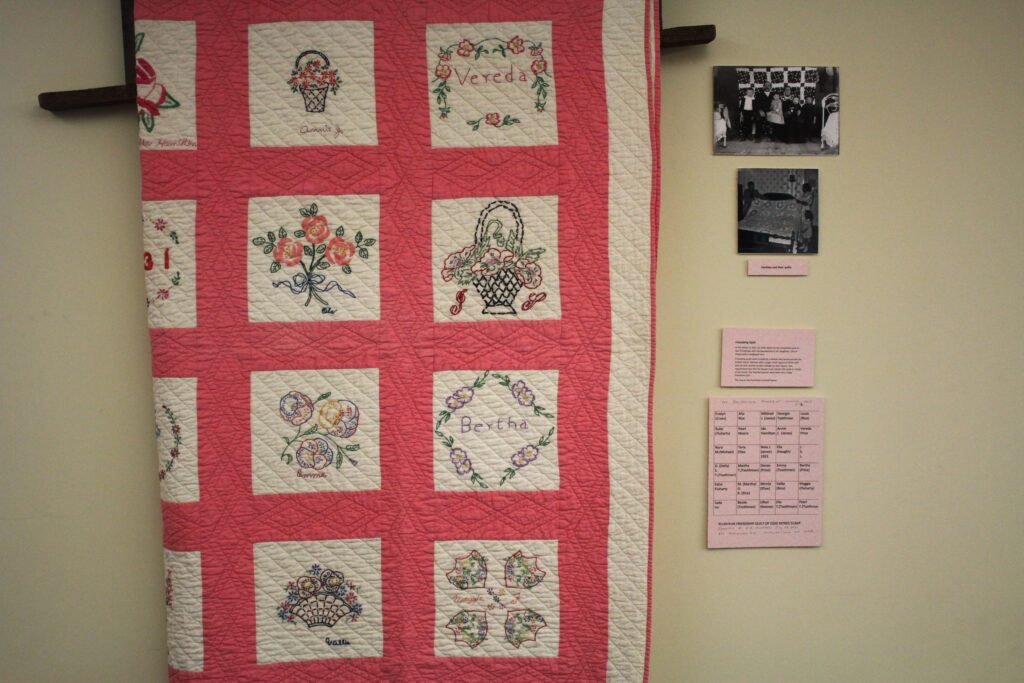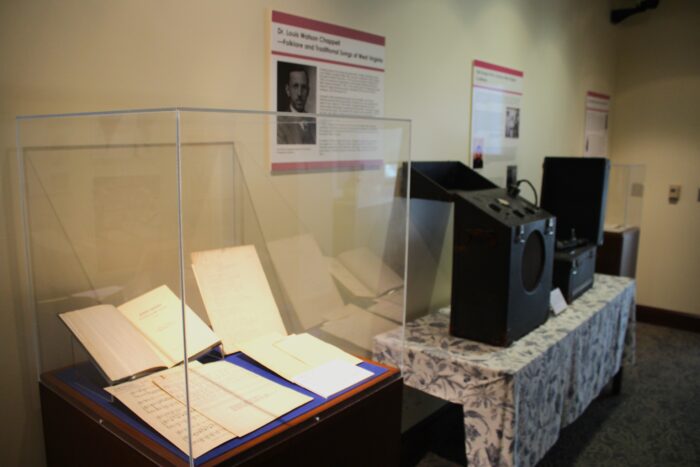LISTEN: Shadowlands Has The Mountain Stage Song Of The Week
This week's premiere broadcast of Mountai...
Continue Reading Take Me to More News
The term “folklife” can evoke the sounds of fiddles and banjoes, or black and white images of grandparents on the old family farm. And those can both be true.
But an exhibit at West Virginia University invites the public to explore how the traditional still influences us today — and how new traditions might influence tomorrow.
Catherine Rakowski is the research and exhibition specialist for the West Virginia and Regional History Center (WVRHC) at West Virginia University in Morgantown. The center is currently displaying a piece of folk art she wasn’t sure she would ever get a chance to show off to the public.
“It’s called a friendship quilt,” Rakowski said.
Rakowski said it’s one of her favorites, and with good reason: some 20 hand-embroidered squares, each containing a floral design, and more importantly the name of its maker, are bordered with pink and white fabric borders.
“Somebody, they’re going to be in charge of all this, they send out squares to friends, relatives, square cloth, and ask the person they’re sending it to to embroider their name on the cloth with the design, and send it back to her,” Rakowski said. “This is the result, and she would piece it together. They always came with maps so you knew who did what.”
It’s the kind of thing most people today only get to see as a family heirloom. But the example on display at the WVRHC made by Emily Myers Gump and her friends almost 100 years ago, is on display as part of the “Living the Folklife: Monsters, Music, Medicine, Myths, and More” exhibit.
“It’s the culture of Appalachia, southern Appalachia, particularly, and West Virginia, of course,” Rakowski said. “What we do with our exhibits, we focus on what we have in our holdings, our collections, and that’s how we build our exhibits and to feature in what we have here.”
That includes what you might expect: fiddles and displays highlighting local legends old and new. But visitors to the exhibit can also see portable, luggage-sized recording equipment used in the 1930s to preserve West Virginia folk music, handmade children’s toys and even a pot still once used to make moonshine.
“We went into every area of folklife, folk art, folk medicine, folk speech, folk food, folk festivals, folk tales, that kind of thing,” Rakowski said.

Rakowski said folklife – as the exhibit’s name implies – goes hand in hand with life in the Appalachia and its role as a melting pot for European, Native American and African cultures.
“That’s a culture, and it all blended together because the mountains divided us,” she said. “You couldn’t get anywhere. Infrastructure was a problem. So, like I said, it blended together. That’s how I see it. Anyway, geography had a lot to do with it.”
Rosemary Hathaway recently retired as an English professor at WVU. She helped open the exhibit on West Virginia Day with a presentation on folklife.
“The best definition, I think, of folklore, is sort of the art of everyday life, in the sense that it’s the things that people say or do or create that give their lives meaning and give expression to their values or their communities,” Hathaway said.
According to Hathaway, West Virginia has always been conscious of the importance of its folk traditions and supportive of them. The exhibit highlights the work of folklorists like Louis Watson Chappell and Patrick Gainer, who formalized their work with state support at WVU.
Hathaway pushes back against the idea of an isolated region giving rise to the rich folklife explored in the exhibit. But she does agree that a sense of place has kept many traditions alive.
“This perception of Appalachia as this place of otherness and difference and poverty and kind of the stereotypes about Appalachia, I think, rather than making people feel ashamed of their traditions or replace them with something modern, I think it’s had the exact opposite effect,” she said. “I think it’s really made people appreciate that this is valuable.”
The WVRHC is tucked away on the sixth floor of the university’s Downtown Library. Most come here on a mission, seeking out research material for a dissertation or genealogy info for a family tree.
But Hathaway said it’s worth taking a trip up to the center to learn not only how the old ways live on, but also how new traditions like cryptids – popular creatures like Mothman that lack conclusive evidence of their existence – fit into the folklife mosaic.
“They might think about music, but they might think about that in a really limited way, too.” she said. “You know that, ‘Oh, it’s an old guy sitting on his porch, playing his fiddle.’ I think this exhibit really will open people’s eyes to the breadth of what counts as folklife in West Virginia, and not just in the past. But what are people doing now, right? What are the kinds of traditions that people are engaging in presently, that count as folklife?”
Rakowski said you might even learn something that could come in handy down the road.
“It’s a link. You’re linking yourself to the past,” she said. “And I’ll tell you what, maybe someday we might have to go back to stringing beans again. You never know, but it’s a wonderful tradition to do that, to preserve.”
The folklife exhibit is open to the public during regular library hours through the spring semester.
